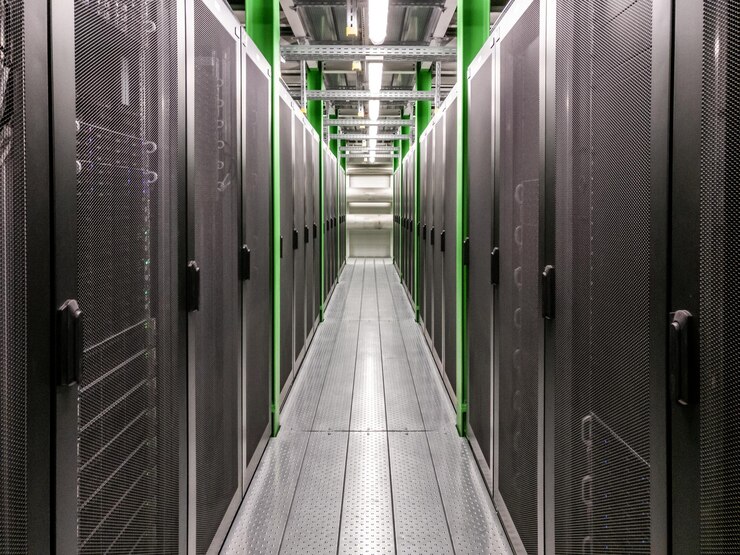Data centers, in a way, house massive amounts of IT equipment—servers, storage devices, and network hardware—all of which generate heat during operation. No surprise they are needed more than ever. Without proper cooling, these devices can overheat, leading to hardware failures, reduced efficiency, and even data loss. Cooling systems, therefore, play a critical role in maintaining the health of the equipment, improving operational performance, and reducing energy consumption.
With rising demands for cloud computing and digital services, the cost of data center cooling has been recently on the rise too. Understanding data center cooling costs and how to optimize them is essential for any data center operator looking to improve both performance and profitability. Cooling is also one of the most significant areas of focus when it comes to types of data center at cooling trends and adopting more sustainable methods.
Understanding the Basics of Data Center Cooling
Before diving into the different cooling technologies, it’s important to grasp the core concept of cooling in a data center. Cooling ensures that the temperature of the servers remains within a safe operating range, typically between 18°C and 27°C (64°F to 81°F). To achieve this, several data center cooling methods are employed, ranging from traditional air-based systems to advanced liquid cooling technologies.
Read more: Data Center Electromagnetic Waves
Key Components of a Data Center Cooling System
- CRAC Units (Computer Room Air Conditioning): These are traditional air cooling systems used in many data centers. They circulate chilled air throughout the room to cool the equipment.
- Airflow Management: Optimizing airflow through raised floors or overhead ducts to direct cool air to where it’s most needed.
- Chillers: These are enacted to cool the air before it is circulated in the data center. They work in tandem with CRAC units to reduce the temperature of the incoming air.
- Pumps and Heat Exchangers: These usually manage the temperature of the water used in some cooling systems.
Types of Data Center Cooling Systems
There are several cooling solutions available, each with its own advantages and limitations. The choice of system depends on factors such as the size of the data center, its power density, and the overall energy efficiency goals. In the following, we are presenting different typical systems they employ as data center cooling.
-
Air Cooling Systems
Air cooling is the most common and traditional cooling method used in data centers. This is achieved through Computer Room Air Conditioning (CRAC) or Computer Room Air Handler (CRAH) units.
In these systems, cold air is introduced into the room, and warm air is drawn out to keep the temperature stable. These units work by cooling the air through refrigeration or using chilled water.
What makes air cooling effective is that it’s relatively simple and cost-effective, especially for small to mid-sized data centers. However, as the demands for higher server densities grow, air cooling systems may struggle to maintain an optimal temperature, making them less efficient in larger setups.
Despite its simplicity, air cooling has its drawbacks. It can require substantial amounts of energy to keep the air temperature low enough, especially in high-density environments where heat output is significant. Over time, this can result in higher operational costs.
Related article: What Is a Micro Data Center?
-
In-Row Cooling
In-row cooling places cooling units directly between server racks to manage heat at the source, rather than relying on large central systems. This targeted approach helps to maintain optimal temperature control where it’s needed most.
The main benefit of in-row cooling is that it addresses hotspots more directly, increasing the cooling efficiency in areas where server density is highest. This can help reduce the total amount of cooling power needed by the data center.
The downside, however, is that this system requires careful planning to ensure proper airflow management. Without it, cooling performance can be compromised, and hotspots can form, which could lead to hardware failures.
-
Liquid Cooling Systems
As data centers increase in density and performance, liquid cooling is becoming a more efficient solution. Rather than relying solely on air to carry away heat, liquid cooling directly removes heat from components by passing a liquid coolant through pipes or cooling plates attached to the servers.
Liquid cooling systems excel in high-density environments. The coolant, typically water or a specialized fluid, has a higher thermal conductivity than air, making it much more effective at transferring heat. This allows data centers to cool equipment more efficiently, especially in environments with high-performance computing (HPC) or artificial intelligence workloads.
However, while highly efficient, liquid cooling systems are more complex and costly to implement. The infrastructure required for liquid-based cooling—such as heat exchangers, pipes, and pumps—adds a layer of complexity. Furthermore, the quality of the materials used is crucial, as leaks or corrosion can damage sensitive equipment.
-
Free Cooling (Outside Air Cooling)
Free cooling is a system that takes advantage of cooler outdoor air to cool the data center, eliminating the need for mechanical refrigeration during colder months.
This system works by bringing in outside air, often filtered and cooled to some degree, and circulating it through the data center. When the outdoor air is sufficiently cool, it can replace the need for energy-intensive air conditioning systems, reducing both costs and energy consumption.
The main benefit of free cooling is its “energy efficiency”. It can significantly reduce cooling costs, especially in cooler climates. However, it does have its limitations, as it’s not practical in warmer regions or during heat waves. In such cases, supplemental cooling systems are needed.
If you want to know about data center tiers come here.
-
Immersion Cooling
Immersion cooling is an innovative technology where entire servers or server components are submerged in a non-conductive liquid coolant. The liquid absorbs heat directly from the hardware, allowing for faster and more efficient heat dissipation.
This method is particularly useful in extremely high-density data centers, where traditional air cooling systems would be insufficient. By immersing the components directly in coolant, immersion cooling eliminates the need for air-based cooling.
While highly efficient, immersion cooling is still relatively new and expensive. The setup requires specialized equipment and may not be feasible for all data centers, especially those with limited space or budgets.
How Data Center Cooling Systems Impact Energy Efficiency and Costs
Cooling systems are a major contributor to energy consumption in data centers, often accounting for 30-50% of the total energy usage. Optimizing cooling not only helps improve the performance and longevity of equipment but also reduces operational costs and supports sustainability goals. With the rising importance of data center cooling costs, understanding how to optimize energy usage is crucial for data center operators.
By focusing on more efficient cooling technologies like liquid cooling, free cooling, or immersion cooling, data centers can dramatically reduce their energy consumption, resulting in lower data center cooling costs over time. Many modern cooling methods also contribute to a smaller environmental footprint, helping companies achieve sustainability targets while reducing operating expenses.
Read more: Optimization of Data Center Energy Consumption Using AI
Data Center Cooling Trends: The Future of Cooling Systems
As the demand for computing power grows, so does the need for more efficient cooling solutions. Several data center cooling trends are emerging that focus on reducing energy consumption, lowering operational costs, and improving sustainability. Here are some key trends:
- Use of Artificial Intelligence (AI): AI is increasingly being used to predict cooling requirements and optimize energy use. AI can analyze temperature data and adjust cooling systems in real-time, improving efficiency.
- Adoption of Renewable Energy: Many data centers are incorporating renewable energy sources, such as solar or wind power, into their cooling systems to reduce their carbon footprint and cooling costs.
- Liquid and Immersion Cooling: As data centers become more power-dense, liquid and immersion cooling are becoming more popular. These methods are more efficient at removing heat compared to traditional air-based systems.
Read more: What is a Colocation Data Center?
Best Practices for Managing Data Center Cooling
To ensure the most efficient use of cooling systems, data centers should follow best practices to optimize airflow, reduce cooling demands, and maintain system performance.
To ensure optimal cooling performance and energy efficiency, data centers should implement a set of best practices designed to optimize airflow, reduce energy consumption, and maintain consistent operating conditions. Here are the key practices that every data center should consider:
- Optimize Airflow Management: Effective airflow is the backbone of a well-cooled data center. Implementing hot and cold aisle containment helps prevent the mixing of cool and warm air, ensuring that cold air is directed precisely to the server intakes, while warm air is efficiently exhausted. This strategy minimizes the workload on cooling systems, improving efficiency and reducing unnecessary energy consumption.
- Real-Time Temperature Monitor: Monitoring temperature fluctuations is essential for maintaining an ideal operating environment. By integrating temperature sensors throughout the facility, data center managers can track real-time conditions and adjust cooling systems accordingly. AI-powered solutions can predict temperature changes and automatically regulate cooling, ensuring that equipment stays within optimal temperature ranges without manual intervention. This reduces the risk of overheating and extends the lifespan of the servers.
- Invest in Energy-Efficient Cooling Equipment: The choice of cooling equipment plays a significant role in a data center’s energy consumption. Upgrading to energy-efficient cooling units, such as those that use variable-speed fans or liquid-based cooling, can substantially reduce energy use. Regular maintenance of these systems is equally important to ensure they continue to perform at peak efficiency, preventing issues like clogged filters or degraded cooling performance that can drive up operational costs.
- Plan for Rack Density and Cooling Capacity: As data centers become more power-dense, careful planning of rack density is critical. Proper rack configuration ensures that high-density server racks receive sufficient cooling without overwhelming the system. By strategically placing servers and ensuring airflow paths are clear, data centers can avoid hotspots and ensure that cooling resources are used effectively.
Conclusion: Choosing the Right Cooling System for Your Data Center
Selecting the right cooling system is crucial for ensuring the efficiency, reliability, and sustainability of a data center. As energy efficiency becomes increasingly important, the industry is leaning towards more advanced systems like liquid cooling, free cooling, and immersion cooling. By understanding the various data center cooling methods in Dana Cloud and staying informed on data center cooling trends, data center operators can make informed decisions that balance energy consumption, operational costs, and environmental impact. With proper cooling strategies in place, data centers can run smoothly, reduce downtime, and improve their overall sustainability.



